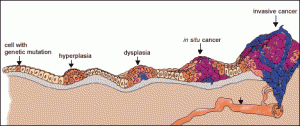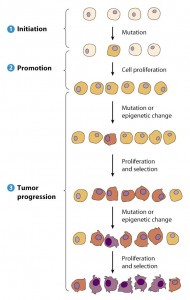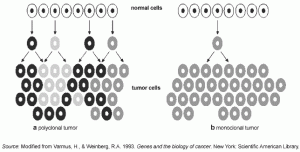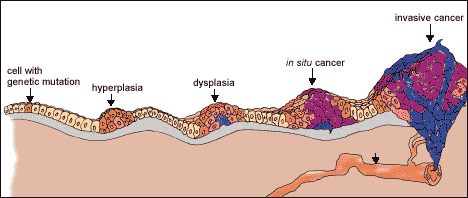Cancer is a devastating and potentially fatal disease that develops when healthy cells undergo a genetic change and begin to proliferate rapidly and uncontrollably. What happens to cause a cell to become cancerous? Thirty years ago, scientists could not offer a coherent answer to this question. They knew that cancer arose from cells that began to proliferate uncontrollably within the body, and they knew that chemicals, radiation, and viruses could trigger this change. But exactly how it happened was a mystery.
The genetic mutations accumulated by cancer cells allow the cells to proliferate indefinitely, evade cell death and eventually invade other tissues. Although there are several types of cancer, each staged according to specific diagnostic criteria, many cancers have similar steps of disease progression. All of the cells produced by division of this first, ancestral cell and its progeny also display inappropriate proliferation. A tumor, or mass of cells, formed of these abnormal cells may remain within the tissue in which it originated (a condition called in situ cancer), or it may begin to invade nearby tissues (a condition called invasive cancer). An invasive tumor is said to be malignant, and cells shed into the blood or lymph from a malignant tumor are likely to establish new tumors (metastases) throughout the body.
 Research across the last three decades, however, has revolutionized our understanding of cancer. In large part, this success was made possible by the development and application of the techniques of molecular biology, techniques that enabled researchers to probe and describe features of individual cells in ways unimaginable a century ago. Today, we know that cancer is a disease of molecules and genes, and we even know many of the molecules and genes involved. In fact, our increasing understanding of these genes is making possible the development of exciting new strategies for avoiding, forestalling, and even correcting the changes that lead to cancer.
Research across the last three decades, however, has revolutionized our understanding of cancer. In large part, this success was made possible by the development and application of the techniques of molecular biology, techniques that enabled researchers to probe and describe features of individual cells in ways unimaginable a century ago. Today, we know that cancer is a disease of molecules and genes, and we even know many of the molecules and genes involved. In fact, our increasing understanding of these genes is making possible the development of exciting new strategies for avoiding, forestalling, and even correcting the changes that lead to cancer.
Initial Tumor Growth
The first stage of cancer development is the uncontrolled proliferation of cells, which usually forms a tumor. In the earliest stages of cancer, tumor growth remains localized within one part of the tissue. As more as more cancer cells are formed, the tumor cells begin to attack and actively kill healthy cells around the tumor, facilitating the growth of a larger tumor. Depending on the location of the tumor, cancer patients at this stage may notice a range of symptoms, from a palpable mass in tumors near the skin to unexplained pain in the region of tumor growth. If detected at the early stages, many cancers can be effectively treated with radiation therapy, surgery, chemotherapy or other targeted therapies.
Growth Towards Other Tissues
As cancer progresses, tumor cells begin to grow towards neighboring tissues and structures. Many forms of cancer spread to surrounding lymph nodes, organs that help make up a part of the immune system and allow for lymph fluid circulation through lymph vessels. As cancer cells invade lymph nodes, patients may notice symptoms associated with swollen lymph nodes. Enlarged lymph nodes are most easily detected in the armpit, the groin or the sides of the neck, reports the University of Maryland Medical Center. Enlarged lymph nodes deeper within the body may cause pain as the lymph node presses against surrounding nerves and tissues. In some cases, cancers that can spread to the lymph nodes may still be treated with surgery.
Metastasis
 In advanced stages of cancer, the cancer cells metastasize, or begin to colonize in distant organs throughout the body. Cancer cells may enter the bloodstream or the lymph vessels to circulate throughout the body, or they may migrate to organs around the initial tumor. The site of metastasis depends on the characteristics of the cancer cell, and how it is able to interact with the microenvironment in the distant tissue to allow for new tumor growth. Tumors formed as a result of metastasis are called secondary tumors, and they may develop within multiple organs at the same time. Since metastastic typically cancer affects multiple organs, it cannot be effectively treated with surgery, though some patients may undergo surgery to relieve pain associated with cancer progression. The American Cancer Society states that most patients who die from cancer develop secondary tumors, and that metastasis is the cause of death in most cancer cases.
In advanced stages of cancer, the cancer cells metastasize, or begin to colonize in distant organs throughout the body. Cancer cells may enter the bloodstream or the lymph vessels to circulate throughout the body, or they may migrate to organs around the initial tumor. The site of metastasis depends on the characteristics of the cancer cell, and how it is able to interact with the microenvironment in the distant tissue to allow for new tumor growth. Tumors formed as a result of metastasis are called secondary tumors, and they may develop within multiple organs at the same time. Since metastastic typically cancer affects multiple organs, it cannot be effectively treated with surgery, though some patients may undergo surgery to relieve pain associated with cancer progression. The American Cancer Society states that most patients who die from cancer develop secondary tumors, and that metastasis is the cause of death in most cancer cases.
Another field of study that contributed to scientists’ growing understanding of cancer was cell biology. Cell biologists studied the characteristics of cancer cells, through observations in the laboratory and by inferences from their appearance in the whole organism. Not unexpectedly, these investigations yielded a wealth of information about normal cellular processes. But they also led to several key understandings about cancer, understandings that ultimately allowed scientists to construct a unified view of the disease.
One such understanding is that cancer cells are indigenous cells—abnormal cells that arise from the body’s normal tissues. Furthermore, virtually all malignant tumors are monoclonal in origin, that is, derived from a single ancestral cell that somehow underwent conversion from a normal to a cancerous state. These insights, as straightforward as they seem, were surprisingly difficult to reach. How could biologists describe the cell pedigree of a mass of cells that eventually is recognized as a tumor?
One approach to identifying the origin of cancer cells came from attempts to transplant tissues from one person to another. Such transplants work well between identical twins, but less well as the people involved are more distantly related. The barrier to successful transplantation exists because the recipient’s immune system can distinguish between cells that have always lived inside the self and cells of foreign origin. One practical application of this discovery is that tissues can be classified as matching or nonmatching before a doctor attempts to graft a tissue or organ into another person’s body. Such tissue-typing tests, when done on cancer cells, reveal that the tumor cells of a particular cancer patient are always of the same transplantation type as the cells of normal tissues located elsewhere in the person’s body. Tumors, therefore, arise from one’s own tissues, not from cells introduced into the body by infection from another person.
How do we know that tumors are monoclonal? Two distinct scenarios might explain how cancers develop within normal tissues. In the first, many individual cells become cancerous, and the resulting tumor represents the descendants of these original cells. In this case, the tumor is polyclonal in nature. In the second scenario, only one cell experiences the original transformation from a normal cell to a cancerous cell, and all of the cells in the tumor are descendants of that cell.
 Direct evidence supporting the monoclonal origin of virtually all malignant tumors has been difficult to acquire because most tumor cells lack obvious distinguishing marks that scientists can use to demonstrate their clonal relationship. There is, however, one cellular marker that scientists can use as an indication of such relationships: the inactivated X chromosome that occurs in almost all of the body cells of a human female. X-chromosome inactivation occurs randomly in all cells during female embryonic development. Because the inactivation is random, the female is like a mosaic in terms of the X chromosome, with different copies of the X turned on or off in different cells of the body. Once inactivation occurs in a cell, all of the future generations of cells coming from that cell have the same chromosome inactivated in them as well (either the maternal or the paternal X). The observation that all the cells within a given tumor invariably have the same X chromosome inactivated suggests that all cells in the tumor must have descended from a single ancestral cell.
Direct evidence supporting the monoclonal origin of virtually all malignant tumors has been difficult to acquire because most tumor cells lack obvious distinguishing marks that scientists can use to demonstrate their clonal relationship. There is, however, one cellular marker that scientists can use as an indication of such relationships: the inactivated X chromosome that occurs in almost all of the body cells of a human female. X-chromosome inactivation occurs randomly in all cells during female embryonic development. Because the inactivation is random, the female is like a mosaic in terms of the X chromosome, with different copies of the X turned on or off in different cells of the body. Once inactivation occurs in a cell, all of the future generations of cells coming from that cell have the same chromosome inactivated in them as well (either the maternal or the paternal X). The observation that all the cells within a given tumor invariably have the same X chromosome inactivated suggests that all cells in the tumor must have descended from a single ancestral cell.
